By examining examples of chinese pottery in sequence from Chou times to the approach of the T'ang Age, we can follow this momentous chapter of development in ceramics. from a kiln-glazed Chou pot to glazed stoneware masterpieces in the sixth century AD.
Ceramic Technical Achievements
in
Early Imperial China
A number of important technical developments in ceramics reach maturity in the Han era and were refined further during the next centuries.
Lead Glazed Ware
During the early Han Era potters in the central area of China began to explore deeper the use of lead compounds mixed with clay slip to produce rich glossy low temperature glazes. By the 1st century AD in Eastern Han they had achieved a stable richly high-gloss lead glaze on red earthenware (usually covered with a white slip) and fired in non-smoky (oxidised atmosphere) kilns at 850-1000°C. There were two popular coloured Han lead glazes: One contained iron oxide to produce warn yellows ambers and red-browns and the other contained copper oxide to produce a range of leaf greens light to almost black. In different ways these both echoed bronze. Much of Han Lead-glazed ware is press-moulded, immitating funerary bronze forms.the
High-Fire Glazed Ware
An understanding of how to make, apply and fire a smooth reliable high temperature glaze - fluxed with ash and lime; and the flow controlled with clay. Colour - primarily from a trace to 10% of iron oxide - yellow-greys, green-greys, ochres, brown and black colours produced with increasing amounts of iron( mostly from clays) and fired to at least 1200°C with careful kiln atmosphere control (oxidation / reduction). In other words, simple glaze mixtures of clay slip-ash-lime painted on the leather hard grey stoneware, then dried and fired to at least 1200°C.
From a ceramic viewpoint we see a surge of development and innovation in both low fire and high fire ceramics throughout this long period. Most of the important ceramic techniques had been learned but now many were further exploited and refined: moulding, use of the wheel, expert kiln building and firing to high temperatures, decorating, refinement of bodies and glaze experiments. It seems probable that pottery villages or towns in central China specialised in terracottas with the new low temperature lead glazes. There may be traditional or material supply reasons for this. Highfire ceramics seem to have become well-established in the South and eastern coastal provinces even before the Han Era. This is where I believe the hill or cave kiln was invented. Kiln development
For various economic and, cultural reasons pottery in all its forms increasingly replaces bronze tomb furnishings. Ceramic objects become more acceptable as important grave gifts - and eventually are considered very desirable art objects. During this period ceramics begins to be recognised as an important art form as well as a versatile material for building and domestic utensils. Changes in fashion and taste and, above all, the attractive qualities of the new ceramic techniques, materials and coloured paint and glazes contributed to the rapid growth in the status of ceramics during the Han Empire and beyond.
changes in fashion and taste and, above all,
the attractive qualities of the new ceramic techniques, materials and coloured paint and glazes
contributed to the rapid growth in the status of ceramics during the Han Empire.
Potters. What evidence there is points to an expansion of opportunities for potters and the pottery industry during the Han dynasty. The was relative stability, expanding trade within China andnow much more with the outside Western World via the various parts of the "silk Route. to the West( Middle East/Mediterranean World).A range of aristocrats, merchants and civil servants were the market for new, fashionable, colourful goods to furnish increasingly elaborate tombs. During the next 400 years potters produced A variety of figures, models and ceremonial vessels, many previously made in bronze; available first in painted earthenware and later in rich glossy lead glaze in ambers browns and deep greens. Much of this work was I believe made in kilns in the central area of Han China where the First Emperor had establish a large ceramic industry around the Yellow river. These kilns were primarily earthenware updraft kilns.
The death of the first Emperor in 210BC, there was a period of internal conflict and social revolution. Liu Pang (probably the son of a village headman, who had been en-nobled as Prince of Han) found his authority as leader of the growing band of insurgents. In 206-207BC he led his troops against the Ch'in army and defeated them.
WESTERN HAN 206-12 BC
In 202 Liu Pang eliminated his rival and after a short civil war, proclained himself Emperor of a new dynasty, called Han, with his capital at Ch'ang-an (present-day Sian or Xian).
He resolved or reversed many of the changes which had contributed to the social revolt. Some power was restored to the feudal chieftains and the harsh levees for communal work demanded of the peasants were reduced. The teachings of Confucius and others were now allowed and many of the harsher aspects of the previous dynasty were modified if not lifted.
However, much of the Ch'in centralising changes and innovations such as improvements in road and bridge building defencive walls and standardising of weights and measures and written language were not reversed by the Han Emperors.
The Han retained much of the Ch'in administrative structure but retreated a bit from centralized rule by establishing vassal principalities for the sake of political convenience.
After 200 years, Han rule was interrupted briefly in AD 9 to 24 by Wang Mang, a reformer. Unfortunately his admirable and necessary reforms were not popular and he was deposed ending the short Hsin Dynasty 12-23 AD. The Han Dynasty was restored in a capital further east and struggled on for another 200 years.
EASTERN HAN 25-221 AD
The Han rulers, however, were unable to adjust to what centralization had wrought: a growing population, increasing wealth and resultant financial difficulties and rivalries, and ever-more complex political institutions. Towards the end of the second century AD the Han Empire began to fall apart as the large landholding families, taking advantage of the weakness of the imperial government, established their own private armies. This is when the era of disunity began Riddled with corruption often in the Palace, within Royal Family or officials this decay is characteristic of Chinese dynastic cycle, by AD 220, the Han Empire collapsed.
Era of Disunity - (AD 220 to 618 -- 399 Years)
The earlier, "unofficial" part of the period, from 190 to 220, was marked by
chaotic infighting between warlords in various parts of China.
Towards the end of the second century AD the Han Empire began to fall apart as the large landholding families, taking advantage of the weakness of the imperial government, established their own private armies. This is when the era of disunity began - towards the end of the first century AD in the Eastern Han
Three Kingdoms and Western Chin Period (219-316)
Finally, in 220 the son of Tao Tao seized the throne and established the Wei Dynasty (220-265). Soon, however, leaders with dynastic aspirations sprang up in other parts of the country. The Shu Dynasty (221-263) was established in the southwestern China, and the Wu Dynasty (222-280) in the southeast.
The middle part of the period, from 220 and 263, was marked by a more militarily
stable arrangement between three rival states, Kingdom of Wei (魏), Kingdom of Han
and Kingdom of Wu. The later part of this period was marked by the
collapse of the tripartite situation: first the destruction of Shu by Wei (263),
then the overthrow of Wei by the Jin Dynasty (265), and the destruction of Wu
by Chin (280).
The Three Kingdoms period is one of the bloodiest in Chinese history.
A population census in late Eastern Han Dynasty reported a population
of approximately 56 million, while a population census in
early Western Chin dynasty (after Chin re-unified China) reported
a population of approximately 16 million.
Even taking into account the inaccuracies of these census reports,
it's safe to assume that a large percentage of the population was wiped out
during the constant wars waged during this period.
In 265 a powerful general of the Wei Dynasty, usurped the throne and established the Western Chin Dynasty (265-317) in North China. By 280 he had reunited the north and south under his rule. Soon after his death in 290, however, the empire began to crumble. The Chin could not long contain the invasions of the nomadic peoples. Invasions began in 304, and by 317 the tribes had wrested North China from the Chin Dynasty. In AD 317 the Chin court was forced to flee from Luoyang and reestablished itself at Nanjing to the south - on the south side of the Yangsi River.
Eastern Chin Dynasty and five Principalities (317-419)
For almost three centuries North China was ruled by one or more non-Chinese dynasties, while the south was ruled by a sequence of four Chinese dynasties. None of the non-Chinese dynasties were able to extend their control over the entire North China plain until 420, when the Northern Wei Dynasty did so.
Southern and Northern Dynasties
NAN-PEI-CH'AO I 420-500
NAN-PEI-CH'AO II 501-580
These two dynasties was an age of civil war and disunity, but there were technological advances - Gunpowder was invented, techniques in medicine and cartography.
During this period the process of sinofication accelerated among the non-Chinese arrivals in the north and among the aboriginal tribesmen in the south. In 534, the tribal chieftains, pushed beyond their endurance, rebelled and the dynasty toppled. For the next 50 years, North China was again ruled by non-Chinese.
Sui Dynasty (581-618)
The Sui Dynasty followed the Southern and Northern
Dynasties and preceded the Tang Dynasty in China. It ended nearly four centuries of
division between rival regimes.
In 589, China was again reunited under the rule of the Sui Dynasty (589-618). The first Sui Emperor was a military servant who usurped the throne of the non-Chinese Northern Zhou in 581. During the next eight years he completed the conquest of South China and established his capital at Changan (now Xi'an). The brief reign of the Sui Dynasty was a time of great activity. The Great Wall was repaired at enormous cost in human life. A canal system, which later formed the Grand Canal, was constructed to carry the agriculture of the Yangtze to the north. Chinese control was reasserted over the tribes of the north and west. A prolonged campaign against the kingdom in southern Manchuria and northern Korea, however, ended in defeat. With its prestige tarnished and the population impoverished, the dynasty fell in 617 to rebels led by Li Yuan who began the Tang Dynasty. Despite the political disunity of the times, there were notable technological advances. The invention of gunpowder and the wheelbarrow is believed to date from the sixth or seventh century. Advances in medicine, astronomy, and cartography are also noted by historians.
The Sui Dynasty, founded by Emperor Wen, or Yang Jian, held its capital at
Chang'an (present-day Xi'an). It was marked by the reunification of Southern and
Northern China and the construction of the Grand Canal, though it was a relatively
short Chinese dynasty. It saw various reforms by Emperors Wen and Yang: the land
equalization system, initiated to reduce the rich-poor social gap, resulted in
enhanced agricultural productivity; governmental power was centralized, and coinage
was standardized and unified; defense was improved, and the Great Wall was expanded.
Buddhism was also spread and encouraged throughout the empire, uniting the varied
people and cultures of China.
This dynasty has often been compared to the earlier Qin Dynasty in tenure and the
ruthlessness of its accomplishments. The Sui dynasty's early demise was attributed
to the government's tyrannical demands on the people, who bore the crushing burden
of taxes and compulsory labor. These resources were overstrained in the completion
of the Grand Canal--a monumental engineering feat-- and in the undertaking of other
construction projects, including the reconstruction of the Great Wall. Weakened by
costly and disastrous military campaigns against Goguryeo which ended with defeat
of Sui in the early seventh century, the dynasty disintegrated through a combination
of popular revolts, disloyalty, and assassination.
Buddhism and the Sui Dynasty
Buddhism was popular during the Six Dynasties period that preceded the Sui dynasty,
spreading from India through Kushan Afghanistan into China during the Late Han period.
Buddhism gained prominence during the period, when central political control was limited.
Buddhism created a unifying cultural force that uplifted the people out of war and into
the Sui Dynasty. In many ways, Buddhism was responsible for the rebirth of culture in
China under the Sui.




That was the last illustration.
I hope you have found Tutorial No.10 interesting and perhaps useful.
The next Tutorial No.11 is the third tutorial of eight on Chinese Ceramics.

That was the last illustration in this tutorial

revision date at the top of page
Victor Bryant ©1994,2006

















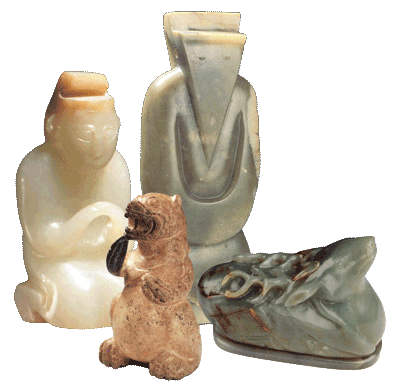




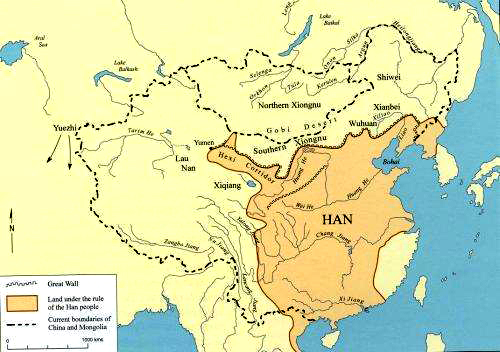
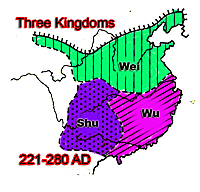 After the Han dynasty collapsed, lead glazing disappeared for some centuries. For four hundred years there followed periods of widespread disorder and instability as the Empire broke up into three, then half-a-dozen warring states.
After the Han dynasty collapsed, lead glazing disappeared for some centuries. For four hundred years there followed periods of widespread disorder and instability as the Empire broke up into three, then half-a-dozen warring states. 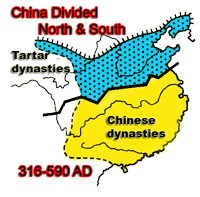 The rivalry and open warfare between these Chinese princes made easier the penetration of the Huns and Mongols into northern China. Eventually the North was effectively under the control of the northern invaders. Many Chinese fled south - especially the rich and cultured. China now contained two separate cultures - North and South of the Yangsi River. This cultural divide lasted some three hundred years.
The rivalry and open warfare between these Chinese princes made easier the penetration of the Huns and Mongols into northern China. Eventually the North was effectively under the control of the northern invaders. Many Chinese fled south - especially the rich and cultured. China now contained two separate cultures - North and South of the Yangsi River. This cultural divide lasted some three hundred years. 

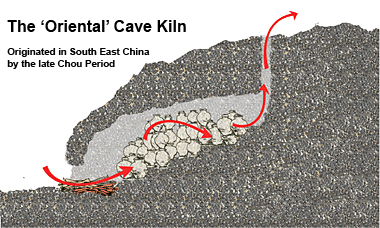
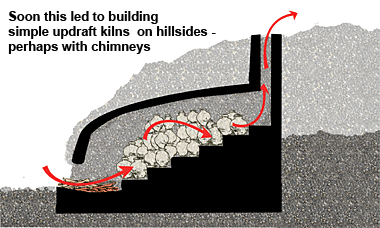
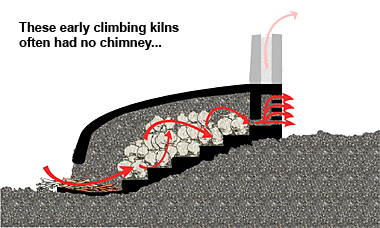
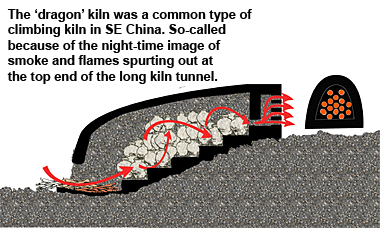
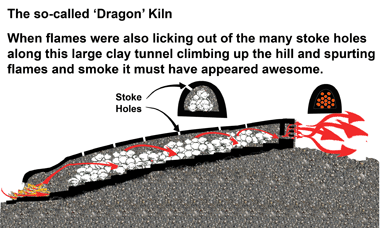
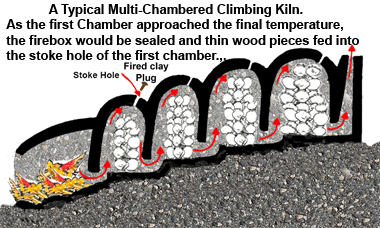
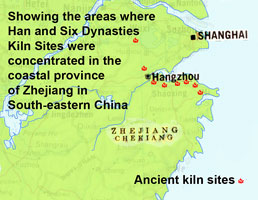 To the south of the Yangtse river, along the estuary around Hang-chou in northern Zhejiang/Chekiang province are the remains of many ancient kiln sites from this time along the southen banks of the Ch'ien-t'ang River from the the estuary westwards to Hang zhou city. Unfortunately all the kiln remains found so far in too ruined a condition to tell us much about structure or firing. All the indications however are that the Shang and Chou high-fired stoneware tradition continued to develop as the Eastern Han glazed stoneware tradition and by the third century AD glazed stoneware was fired in single or multiple chambers. No only were articles for daily use, such as pitchers, jars and dishes being made in quantity, but more refined glazed stoneware for ritual and burial use were rapidly replacing bronze castings during this time.
To the south of the Yangtse river, along the estuary around Hang-chou in northern Zhejiang/Chekiang province are the remains of many ancient kiln sites from this time along the southen banks of the Ch'ien-t'ang River from the the estuary westwards to Hang zhou city. Unfortunately all the kiln remains found so far in too ruined a condition to tell us much about structure or firing. All the indications however are that the Shang and Chou high-fired stoneware tradition continued to develop as the Eastern Han glazed stoneware tradition and by the third century AD glazed stoneware was fired in single or multiple chambers. No only were articles for daily use, such as pitchers, jars and dishes being made in quantity, but more refined glazed stoneware for ritual and burial use were rapidly replacing bronze castings during this time.